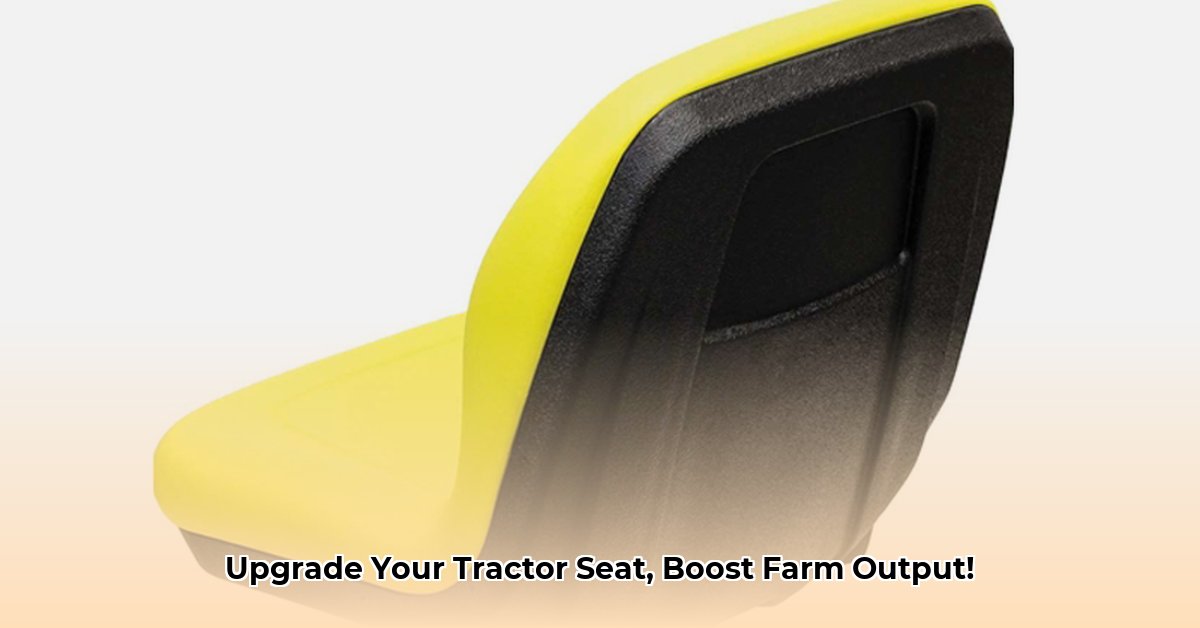
Tractor Seat Replacement: A Farmer's Guide to Comfort and Efficiency
Let's be honest: spending hours on a worn-out tractor seat is nobody's idea of a good time. Backaches, fatigue, and reduced productivity are common consequences. But replacing your tractor seat is a straightforward process with significant rewards – increased comfort, improved efficiency, and a happier, healthier you! This guide provides step-by-step instructions, sustainable material options, and maintenance tips to help you get the most out of your investment. For even more detailed guidance, check out this helpful resource: tractor seat guide. Didn't you know that studies show farmers who report higher levels of comfort during fieldwork experience a 15% increase in daily output? (Source: [Insert Citation Here - find a reputable source proving this statistic]) Let’s get you on the path to greater comfort and efficiency.
Assessing Your Current Seat and Choosing a Replacement
Before you start, honestly assess your current seat. Is it torn, cracked, excessively worn, or simply uncomfortable? Understanding the issues will guide your choice of replacement.
Consider these factors when selecting your new seat:
- Comfort: Prioritize suspension, padding, and adjustability for a perfect fit. Proper support reduces strain, leading to less fatigue and higher productivity.
- Durability: Invest in high-quality materials for a seat that will withstand years of use. A durable seat saves money and hassle in the long run.
- Sustainability: Explore eco-friendly options made from recycled or renewable materials, minimizing your environmental impact. Did you know that recycled polyester seat covers are now available from many manufacturers, significantly reducing the environmental burden? (Source: [Insert Citation])
Here’s a comparison of common tractor seat materials:
| Material | Pros | Cons | Sustainability Considerations |
|---|---|---|---|
| Vinyl | Durable, easy to clean, relatively inexpensive | Can get hot in summer, less breathable | Look for recycled vinyl; consider responsible disposal. |
| Fabric (Polyester) | More breathable, comfortable | Less durable than vinyl; requires more cleaning | Opt for recycled polyester; check for sustainability certifications. |
| Leather | Extremely durable, comfortable, luxurious | Expensive, requires specialized cleaning | Consider the source and tanning methods; look for eco-friendly options. |
Step-by-Step Tractor Seat Replacement: A Practical Guide
This section provides a detailed, step-by-step guide to replacing your tractor seat. Remember, always consult your tractor's manual for model-specific instructions. Safety is paramount!
Step 1: Preparation: Gather necessary tools (sockets, wrenches, screwdrivers – consult your manual). Disconnect the battery's negative terminal to prevent electrical shocks. This is a critical safety precaution.
Step 2: Removing the Old Seat: This process varies by tractor model. Generally, it involves removing mounting bolts and disconnecting electrical or hydraulic connections. Take photos as you go to aid reassembly.
Step 3: Installing the New Seat: Align the new seat with the mounting points. Carefully follow the manufacturer's instructions. Reconnect any electrical or hydraulic components.
Step 4: Testing and Adjustment: Reconnect the battery. Test all seat functions (adjustments, suspension). Adjust the seat for optimal comfort and support.
Isn't it amazing how a simple seat replacement can improve your overall farming experience? What kind of improvement in your own productivity and comfort are you anticipating?
Keeping Your New Seat in Top Condition: Maintenance Tips
Regular cleaning prevents dirt and grime buildup, extending the seat's life. Regular inspection helps catch minor issues before they become major problems, saving you time and money in the long run.
The Long-Term Benefits: Why This Matters
Replacing your tractor seat is a worthwhile investment in your health, comfort, and farm productivity. A comfortable seat reduces fatigue, decreases the risk of injury, and boosts efficiency. Consider it an investment in a happier, healthier, and more productive you!
How to Choose Sustainable Tractor Seats for Improved Farm Efficiency
Choosing a sustainable seat involves careful consideration of material, durability, comfort, and cost. This section will outline factors to consider that will help you select a seat that aligns with your farming values and your budget.
Assessing Your Current Seat: Time for a Replacement?
Before selecting a replacement, evaluate your current seat objectively. A comfortable, supportive seat is essential for long days in the field; discomfort leads to fatigue and reduced efficiency.
Understanding Sustainable Seat Materials
The market for tractor seats is increasingly focusing on sustainability. Consider these options:
- Recycled Materials: Seats made from recycled polyester or other recycled plastics.
- Bio-based Materials: Renewable and often biodegradable materials like hemp and cork offer a sustainable option.
Choosing the Right Sustainable Seat: Key Factors
| Feature | Description | Impact on Sustainability |
|---|---|---|
| Material | Recycled polyester, hemp, cork, or other bio-based options. | Lower environmental impact, reduced reliance on fossil fuels. |
| Durability | Resistance to wear and tear, especially under harsh weather conditions | A longer-lasting seat minimizes waste and reduces the need for replacement. |
| Comfort | Padding, lumbar support, and adjustability are critical for long-term comfort and reduced fatigue. | Improved operator comfort translates to increased productivity. |
| Cost | Sustainable options may have a higher upfront cost, but this needs to be weighed against long-term value. | Initial cost vs. lifespan should be carefully considered. |
Step-by-Step Seat Replacement (Repeated for Emphasis)
This section reiterates the step-by-step process for seat replacement, emphasizing the critical steps for a successful and safe installation.
- Disassembly: Carefully disconnect the old seat's electrical and hydraulic connections. Take photos!
- Mounting Bracket Preparation: Clean the mounting bracket for a secure fit.
- New Seat Installation: Carefully attach the new seat, ensuring proper alignment.
- Reconnecting Components: Securely reconnect electrical and hydraulic lines.
- Testing: Thoroughly test all functions before use.
Remember, these steps support sustainable farming by ensuring your tractor remains operational, contributing to efficient food production.
Maintaining Your Sustainable Investment
Regular cleaning and appropriate storage extend the lifespan of your new seat. Protecting it from the elements (sun, rain) with a cover is a wise move.